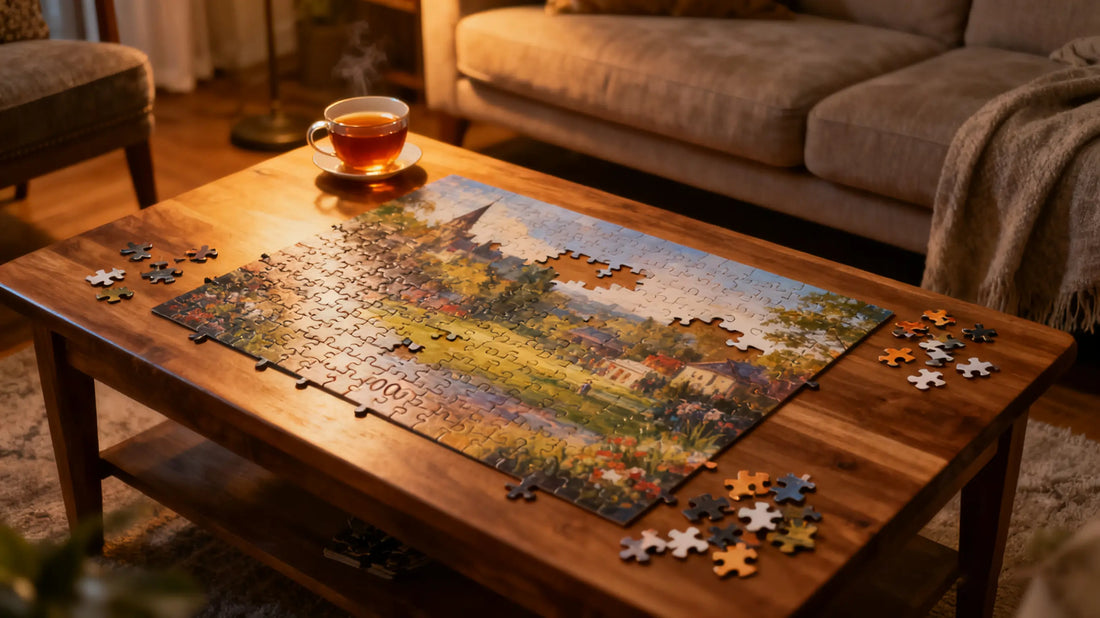
How Big Is a 1,000 Piece Puzzle? Everything You Need to Know
Share
Introduction
If you’re a puzzle lover, chances are you’ve either completed or considered tackling a 1,000 piece puzzle. For many enthusiasts, this piece count represents the perfect balance—challenging enough to feel rewarding, but not so overwhelming that it takes months to finish. One of the first questions people ask is: “How big is a 1,000 piece puzzle?” The answer isn’t as simple as giving one size because the dimensions can vary depending on the brand, piece cut, and manufacturing process. This article breaks down everything you need to know about the size of a standard 1,000 piece puzzle, how much space you’ll need, and even tips for storing or displaying your completed masterpiece.
Standard Size of a 1,000 Piece Puzzle
On average, a standard 1,000 piece jigsaw puzzle measures between 20 x 27 inches (51 x 69 cm) and 28 x 20 inches (71 x 51 cm). While these measurements are fairly consistent, not all puzzles are exactly the same size. The dimensions depend largely on how the manufacturer designs the grid layout—some puzzles are cut into 38 x 27 pieces, others into 40 x 25, which results in different overall shapes and aspect ratios.
For example:
Ravensburger: ~27 x 20 inches (69 x 50 cm)
Buffalo Games: ~26.75 x 19.75 inches (68 x 50 cm)
Clementoni: ~27.2 x 19.7 inches (69 x 50 cm)
So, while you can expect most 1,000 piece puzzles to fall within a fairly narrow size range, it’s still worth checking the box before you buy.
Why Sizes Differ Between Brands
The variations between brands often come down to how the puzzle is cut:
Piece Shape: Some brands use more irregular cuts, which can slightly alter the dimensions.
Grid Layout: A puzzle that’s 38 x 27 will have a different size than one that’s 40 x 25, even with the same number of pieces.
Border Style: Some puzzles include decorative edges or uniquely shaped borders, which can add to or reduce the size.
How Much Space Do You Need?
Since most 1,000 piece puzzles are about 20 x 27 inches, you’ll need a flat surface slightly larger than this. Dining room tables, coffee tables, or dedicated puzzle boards are all great options.
If you don’t have a permanent puzzle table, you may want to try a roll up puzzle board, which allows you to safely store your in-progress puzzle and resume later. (👉 Learn more in our guide: Roll Up Puzzle Boards vs. Traditional Boards: Which Fits You Best?)
Tips for Choosing the Right Puzzle Size
Here are a few things to consider when selecting a puzzle:
Available Space: Make sure you have at least 2–3 inches of clearance around the puzzle for trays, pieces, and drinks.
Experience Level: While a 1,000 piece puzzle is manageable for beginners, a 500-piece option may be more comfortable if you’re just starting out.
Visual Style: Dark, repetitive, or abstract images can make the puzzle feel more difficult, even if the size is the same.
How to Store and Display Your Finished Puzzle
After spending hours (or even days) completing your puzzle, the last thing you want to do is take it apart right away. Thankfully, there are creative ways to preserve your work:
Use puzzle glue to keep the pieces together and then frame it as wall art.
Store the puzzle flat in a portfolio case for safekeeping.
Mount it on foam board if you’d like to rotate your collection.
For more ideas, check out our detailed article: What to Do with Finished Puzzles Instead of Taking Them Apart.
Health and Cognitive Benefits of Puzzle Solving
Beyond entertainment, puzzles also come with proven brain benefits. Working on a 1,000 piece puzzle can help improve memory, problem-solving skills, and concentration. It also provides a calming, almost meditative effect that reduces stress.
If you’re curious about the science behind this, we’ve covered it in detail here: Are Jigsaw Puzzles Good for Your Brain? Science-Backed Benefits Explained.
For additional research, you can also check out this article from Healthline on the cognitive benefits of puzzles.
Frequently Asked Questions
1. How many pieces across and down are in a 1,000 piece puzzle?
Most 1,000 piece puzzles are arranged in a grid of around 38 x 27 or 40 x 25.
2. Is a 1,000 piece puzzle too big for beginners?
Not at all! While it can be challenging, with patience and a few strategies (like sorting edge pieces first), beginners can absolutely enjoy it.
3. How long does it take to finish?
It varies. An experienced puzzler may complete one in 5–12 hours, while casual players may spread it over a week or more.
Conclusion
So, how big is a 1,000 piece puzzle? While the exact dimensions vary by brand, you can expect them to measure roughly 20 x 27 inches (51 x 69 cm). This makes them large enough to provide a fun challenge, yet still small enough to fit on most dining tables or puzzle boards. Whether you’re solving one for brain benefits, stress relief, or simply the joy of fitting the pieces together, a 1,000 piece puzzle is an excellent choice for both beginners and seasoned puzzlers.
And once you’re done? Don’t just take it apart—consider framing it or storing it as a lasting reminder of your hard work.
